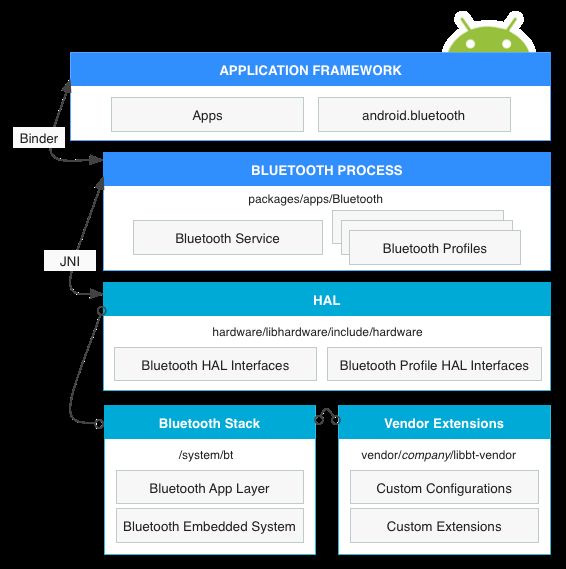蓝牙之六-A2dp代码调用流程

上图描述的是蓝牙协议栈,通过该图,查看A2dp的代码在协议栈的调用流程。其分层架构如下:
1.蓝牙的系统服务service通过JNI与bluedroid协议栈进行通信。协议栈分为两层,Bluetooth Embedded System(BTE)和Bluetooth Application Layer(BTA)。这两层和framework层应用进行通信。
2.蓝牙服务通过Binder IPC通信与应用程序交互。
3.系统服务给开发者提供了获取各种profile的接口。
Application framework
该层使用android.bluetooth APIs和Bluetooth hardware进行通信。通过Binder IPC机制和Bluetooth进程进行通信。该层代码位于frameworks/base/core/java/android/bluetooth/目录下。
如A2DP连接frameworks/base/core/java/android/bluetooth/BluetoothA2dp.java
public boolean connect(BluetoothDevice device) {
if (DBG) log("connect(" + device + ")");
if (mService != null && isEnabled() &&
isValidDevice(device)) {
try {
return mService.connect(device);
} catch (RemoteException e) {
Log.e(TAG, "Stack:" + Log.getStackTraceString(new Throwable()));
return false;
}
}
if (mService == null) Log.w(TAG, "Proxy not attached to service");
return false;
}
该方法通过Binder IPC通信机制,调用packages/apps/Bluetooth/src/com/android/bluetooth/a2dp/A2dpService.java下的内部私有类。通过aidl机制实现。
private static class BluetoothA2dpBinder extends IBluetoothA2dp.Stub {
public boolean connect(BluetoothDevice device) {
A2dpService service = getService();
if (service == null) return false;
return service.connect(device);
}
} 然后调用到A2dpService的connect的方法。
public class A2dpService extends ProfileService {
...
public boolean connect(BluetoothDevice device) {
enforceCallingOrSelfPermission(BLUETOOTH_ADMIN_PERM,
"Need BLUETOOTH ADMIN permission");
if (getPriority(device) == BluetoothProfile.PRIORITY_OFF) {
return false;
}
ParcelUuid[] featureUuids = device.getUuids();
if ((BluetoothUuid.containsAnyUuid(featureUuids, A2DP_SOURCE_UUID)) &&
!(BluetoothUuid.containsAllUuids(featureUuids ,A2DP_SOURCE_SINK_UUIDS))) {
Log.e(TAG,"Remote does not have A2dp Sink UUID");
return false;
}
int connectionState = mStateMachine.getConnectionState(device);
if (connectionState == BluetoothProfile.STATE_CONNECTED ||
connectionState == BluetoothProfile.STATE_CONNECTING) {
return false;
}
mStateMachine.sendMessage(A2dpStateMachine.CONNECT, device);
return true;
}
....
private static class BluetoothA2dpBinder extends IBluetoothA2dp.Stub {
public boolean connect(BluetoothDevice device) {
A2dpService service = getService();
if (service == null) return false;
return service.connect(device);
}
}
} 上述过程就是Bluetooth application framework与Bluetooth process的调用过程。
Bluetooth System service
这部分代码位于packages/apps/Bluetooth下,在framework层实现蓝牙服务和各种profile,以apps形式存在。该层通过JNI调用HAL层代码。
A2dpService的connect方法会发送状态机改变消息,
mStateMachine.sendMessage(A2dpStateMachine.CONNECT, device);
这个消息会被A2dpStateMachine对象的processMessage(Message)方法接收:
switch(message.what) {
case CONNECT:
BluetoothDevice device = (BluetoothDevice) message.obj;
broadcastConnectionState(device, BluetoothProfile.STATE_CONNECTING,
BluetoothProfile.STATE_DISCONNECTED);
if (!connectA2dpNative(getByteAddress(device)) ) {
broadcastConnectionState(device, BluetoothProfile.STATE_DISCONNECTED,
BluetoothProfile.STATE_CONNECTING);
break;
}
synchronized (A2dpStateMachine.this) {
mTargetDevice = device;
transitionTo(mPending);
}
// TODO(BT) remove CONNECT_TIMEOUT when the stack
// sends back events consistently
sendMessageDelayed(CONNECT_TIMEOUT, 30000);
break;上述的connectA2dpNative(getByteAddress(device))会通过JNI调用Native方法。
static jboolean connectA2dpNative(JNIEnv *env, jobject object, jbyteArray address) {
jbyte *addr;
bt_bdaddr_t * btAddr;
bt_status_t status;
ALOGI("%s: sBluetoothA2dpInterface: %p", __FUNCTION__, sBluetoothA2dpInterface);
if (!sBluetoothA2dpInterface) return JNI_FALSE;
addr = env->GetByteArrayElements(address, NULL);
btAddr = (bt_bdaddr_t *) addr;
if (!addr) {
jniThrowIOException(env, EINVAL);
return JNI_FALSE;
}
if ((status = sBluetoothA2dpInterface->connect((bt_bdaddr_t *)addr)) != BT_STATUS_SUCCESS) {
ALOGE("Failed HF connection, status: %d", status);
}
env->ReleaseByteArrayElements(address, addr, 0);
return (status == BT_STATUS_SUCCESS) ? JNI_TRUE : JNI_FALSE;
} JNI
和JNI相关的代码在package/apps/Bluetooth/jni目录下,上一节的connectA2dpNative方法就是这个目录的代码。JNI层代码调用到HAL代码并且从HAL接收到回调。
A2dp连接中,会调用sBluetoothA2dpInterface->connect实现。
static void initNative(JNIEnv *env, jobject object) {
const bt_interface_t* btInf;
bt_status_t status;
...
if ( (sBluetoothA2dpInterface = (btav_interface_t *)
btInf->get_profile_interface(BT_PROFILE_ADVANCED_AUDIO_ID)) == NULL) {
ALOGE("Failed to get Bluetooth A2DP Interface");
return;
}
if ( (status = sBluetoothA2dpInterface->init(&sBluetoothA2dpCallbacks)) != BT_STATUS_SUCCESS) {
ALOGE("Failed to initialize Bluetooth A2DP, status: %d", status);
sBluetoothA2dpInterface = NULL;
return;
}
mCallbacksObj = env->NewGlobalRef(object);
} 在initNative中获得sBluetoothA2dpInterface对象。
HAL
硬件抽象层定义了android.bluetooth APIs和Bluetooth process调用的接口。Bluetooth 的HAL层代码在:
hardware/libhardware/include/hardware/bluetooth.h,HAL层的以下代码也要重视:
hardware/libhardware/include/hardware/bt_common_types.h
//A2DP profile定义
hardware/libhardware/include/hardware/bt_av.h
//GATT profile 定义
hardware/libhardware/include/hardware/bt_gatt_types.h
hardware/libhardware/include/hardware/bt_gatt_client.h
hardware/libhardware/include/hardware/bt_gatt_server.h
hardware/libhardware/include/hardware/bt_gatt.h
//HFP profile定义
hardware/libhardware/include/hardware/bt_hf.h
//HDP profile 定义
hardware/libhardware/include/hardware/bt_hl.h
//MAP profile
hardware/libhardware/include/hardware/bt_mce.h
//HFP client profile
hardware/libhardware/include/hardware/bt_hf_client.h
//pan profile
hardware/libhardware/include/hardware/bt_pan.h
//AVRCP profile
hardware/libhardware/include/hardware/bt_rc.h
hardware/libhardware/include/hardware/bt_hh.h
//SDP profile
hardware/libhardware/include/hardware/bt_sdp.h
//RFCOMM sockets
hardware/libhardware/include/hardware/bt_sock.hJNI中的sBluetoothA2dpInterface是btav_interface_t结构体,位于hardware/libhardware/include/hardware/bt_av.h中,定义为:
typedef struct {
/** set to sizeof(btav_interface_t) */
size_t size;
/**
* Register the BtAv callbacks
*/
bt_status_t (*init)( btav_callbacks_t* callbacks );
/** connect to headset */
bt_status_t (*connect)( bt_bdaddr_t *bd_addr );
/** dis-connect from headset */
bt_status_t (*disconnect)( bt_bdaddr_t *bd_addr );
/** Closes the interface. */
void (*cleanup)( void );
} btav_interface_t;BT stack
协议栈在/system/bt下,实现了HAL层和扩展配置等。包括BTA和BTE量大组件,BTA实现了蓝牙设备管理、状态管理及一些应用规范。而BTE则通过HCI与厂商蓝牙芯片交互以实现了蓝牙协议栈的通用功能和相关协议。另外,BTE还包括一个统一内核接口(GKI),蓝牙芯片厂商可借助GKI快速轻松得移植蓝牙协议栈到其他操作系统或手机平台上。
A2dp的连接将调用
<system/bt/btif/src/btif_av.c>
static bt_status_t connect_int(bt_bdaddr_t *bd_addr, uint16_t uuid)
{
btif_av_connect_req_t connect_req;
connect_req.target_bda = bd_addr;
connect_req.uuid = uuid;
BTIF_TRACE_EVENT("%s", __FUNCTION__);
btif_sm_dispatch(btif_av_cb.sm_handle, BTIF_AV_CONNECT_REQ_EVT, (char*)&connect_req);
return BT_STATUS_SUCCESS;
}Vendor extensions
增加自定义扩展或者HCI层追踪,可以创建libbt-vendor模块并指定这些组件。